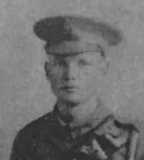Sarnau is a hamlet in the county of Montgomeryshire, to the north of Welshpool, near Llanymynech and within touching distance of the border with England. Penrhos Church was the main place of worship in Sarnau. The lychgate of the Church is a war memorial to its parishioners who fell during the Great War and contains a wooden war memorial, bearing the names of the fallen.
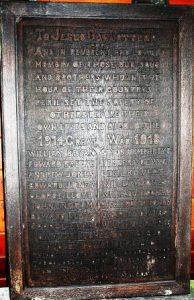
The Great War, 1914-1918
William Edward Breeze, Private, 290821, Royal Welsh Fusiliers. William was the son of David Abraham Breeze and Jane Breeze (nee Lewis), of Groeslwyd, Guilsfield. He worked as a gardener prior to enlisting into the 7th Battalion, Royal Welsh Fusiliers at Welshpool on 9 November 1914. The battalion was a Territorial unit, which mobilised for war at Newtown in August 1914, as part of North Wales Brigade, Welsh Division and moved to Conway until the end of the month, before moving to Northampton. In December the Division moved to Cambridge and then in May 1915 to Bedford, where the Division was numbered and the formation became 158 Brigade, 53rd (Welsh) Division. On 19 July 1915 the entire Division sailed from Devonport for Imbros and on 9 August 1915 landed at Suvla Bay. The infantry moved off the beaches across the Salt Lake, under shellfire, into the scrub covered Chocolate Hill, but due to a lack of maps and no knowledge of the terrain, many of the units became disorientated, and the situation became chaotic. The Division was eventually evacuated from Gallipoli in December 1915, moving to Egypt to join the EEF, and helped guard the Suez Canal before taking part in operations to drive the Turks out of the Sinai. The EEF then turned its attention onto driving the Turks out of Palestine, and on 26 March 1917 launched its first offensive against the coastal city of Gaza, which guarded the road to Jerusalem. Initial gains during the day were lost when the assaulting divisions lost touch with each other, and communication broke down when a thick fog cloaked the battlefield. A second attempt to force Gaza was launched on 17 April, which also failed, and the EEF suffered a change in leadership, with Sir Edmund Allenby assuming command, before being re-organised, and a third offensive was launched against a wider front from Beersheba to Gaza on 31 October 1917. This time the Turkish defences were breached, and the road to Jerusalem now lay open and the EEF began to advance north. On 6 November 1917, 158 Brigade launched an attack on the Khuweilfeh Heights, and once secured, the EEF continued its advance into the Judean Hills, the 53rd Division capturing Hebron and Bethlehem, before securing the Jerusalem to Jericho Road. Allenby finally made his triumphant entry into Jerusalem on 11 December. Over the following months the EEF continued to advance northwards through the Jordan Valley, before Turkey capitulated on 30 October 1918. Sadly, William did not live to see the Armistice with Turkey. He had taken ill just a few weeks previously and died of pneumonia in hospital at Ramleh on 28 October 1918. The 23-year-old is buried in Ramleh War Cemetery, Israel. William is not commemorated on the Guilsfield war memorial.
William Henry Bryan, Private, 707194, Canadian Machine Gun Corps. William was born at Carnarvon on 27 November 1884, the son of Benjamin Bryan and Selina Bryan (nee James). The family had moved to Breidden View, Sarnau by 1891. William emigrated to Canada aboard the SS Sicilian in 1910 and found work as a contractor in Vancouver. William enlisted into the 103rd Battalion, Canadian Expeditionary Force at Vancouver on 3 July 1916. William embarked at Halifax, Nova Scotia on 23 July 1916 and disembarked in Liverpool eight days later before entraining for the Canadian Camp at Shorncliffe. He was then posted to Seaford for training as a specialist machine-gunner, before being drafted to France on 13 March 1917, joining the 5th Company, Canadian Machine Gun Corps, which was attached to the 5th Brigade, 2nd Canadian Division. William joined the battalion at Petit-Servins on 3 April, where it was preparing for the forthcoming Canadian assault on Vimy Ridge. The Canadians successfully attacked and captured the ridge in an action which lasted from 9 to 14 April, then saw further fighting during the Attack on La Coulotte on 23 April. More heavy fighting followed during the Battle of Arleux on 28 April, then the Canadians made a further advance during the Third Battle of the Scarpe on 3 May. The Canadians continued to hold the Lens Sector over the coming months, in atrocious conditions. On 21 July 1917 William was in his dugout on the front line when a German shell crashed into the ground behind, sending shrapnel flying through the entrance. He was struck in the chest and severely injured, so was evacuated to No. 4 Canadian Field Ambulance where he died of his wounds that same day. The 32-year-old was buried in Aix-Noulette Communal Cemetery Extension, France.
William Clarke, Private, 33720, The King’s (Liverpool Regiment). William was the son of William Clarke and Mary Ann Clarke (nee Taylor), of Church Stretton. His father died when he was young, and his mother remarried, so William went to work as a groom at Haimwood, Llandrinio as a young man. William enlisted into the King’s Shropshire Light Infantry at Leominster soon after the outbreak of war, but was later transferred to the 18th Battalion, The King’s (Liverpool Regiment), which was attached to 21 Brigade, 30th Division. The Division embarked for France in November 1915, moving to the Hébuterne sector for trench initiation. It remained on the Somme over the coming months as the Allies built up their forces in preparation for the great Somme offensive and on 1 July 1916 the 30th Division launched an assault from its new positions at Talus Bois, capturing the village of Montauban. The Division saw heavy fighting during the first weeks of the offensive before being moved to the Givenchy sector, near Loos, to rest and rebuild, before moving back to the Somme at the end of September and after a short spell around Naours the Division took over a new section of the Somme front, at Flers, by 11 October. The 18th King’s Liverpool moved into the Flers front line on 17 October in readiness to take part in an assault and on the following morning attacked the German trenches facing Goose Alley. The battalion was relieved during the afternoon and had a brief rest, before moving into the front line again on 19 October 1916. William was killed in action during the relief that day. The 21-year-old has no known grave and is commemorated on the Thiepval Memorial, France.
Edward Charles Davies, Stoker 2nd Class, K/44250, Royal Navy. Edward was born on 15 June 1899, the son of John and Ann Davies, of Sarnau, Llanymynech. He worked as a Cycle Repairer prior to enlisting into the Royal Navy on 19 July 1917 and was posted to HMS Vivid I at Portsmouth for training. Edward had been in uniform for little over a month before he took ill and died of typhoid fever in hospital at Plymouth on 14 September 1917. The 18-year-old was buried in Ford Park Cemetery, Plymouth. His parents later resided at Perthy Cottage, Arddleen.
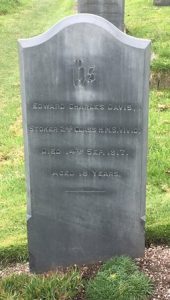
George Fred Evans, Private, 52165, Machine Gun Corps. George was born on 23 April 1895, the son of Alfred and Elizabeth Evans, of Cefnllwyd Cottages, Llansantffraid. He enlisted at Newtown into the 2/1st Battalion, Welsh Horse Yeomanry soon after the outbreak of war. The battalion had formed at Newtown in 1914 and in July 1915 joined the 2/1st South Wales Mounted Brigade in the Dorchester area. During September 1915 the brigade moved to Yoxford joining the 1st Mounted Division. At some time in 1916 George was drafted to France, joining the 2nd Squadron, Machine Gun Corps, a Cavalry unit. The unit formed in France on 28 February 1916, joining the 2nd Cavalry Brigade, 1st Cavalry Division. Due to the stagnant nature of trench warfare, the Cavalry Divisions were rarely used, as there was hardly ever any opportunity during the war to exploit any breakthroughs with the use of mounted troops, so it was not until the Battle of Flers-Courcelette on 15 September 1916, during the Somme offensive, that George would have seen his first major action. The 1st Cavalry Division then took part in the Battle of Arras during April 1917, but remained mainly in reserve to the infantry, ready to mount attacks in case of any breakthroughs. The Division saw heavy fighting during the Cambrai offensive, however, taking part in the initial tank attack on 20 November and being present during the capture of Bourlon Wood, before seeing more fighting following the German counterattacks from 30 November. The 1st Cavalry Division remained in the area over the winter, in positions in front of Roisel, facing the Hindenburg Line. When the Germans launched their great Spring offensive on 21 March 1918, the 1st Cavalry Division was ordered to man its battle positions but suffered mainly from shellfire during the opening day. At about 10.00 on 22 March 1918 the Germans attacked Roisel, and the Machine-Gun crews came into action, desperately trying to stop the advancing German infantry before being surrounded. George was killed in an action during the desperate defence of Roisel that morning. The 22-year-old has no known grave and is commemorated on the Pozieres Memorial, France. He is not commemorated on the Llansantffraid-ym-Mechain war memorial.
Arthur Gwynne Hughes-Davies, MC, Lieutenant, Machine Gun Corps. Arthur was born at Bettws Vicarage, Montgomeryshire on 10 August 1882, the son of Reverend Thomas Hughes-Davies and Frances Maria Hughes-Davies (nee Robinson). His father died when he was young, so his mother moved her young family to live with her father, Reverend Edward Robinson, who was the Vicar of Penrhos Church. Arthur was educated at Burton-on-Trent Grammar School before moving too Brazil in 1909, to work as a Clerk for the London and Brazilian Bank at Ceará. Arthur returned to England in 1915 to enlist into the 7th Battalion, Royal Welsh Fusiliers, gaining a commission as Second Lieutenant on 1 July 1915. Arthur embarked for Egypt in December 1915, joining the 1/7th Battalion, Royal Welsh Fusiliers, which had just been evacuated from Gallipoli. The battalion was attached to 158 Brigade, 53rd (Welsh) Division and joined the EEF on the Suez Canal defences. The EEF then turned its attention onto driving the Turks out of Palestine, and on 26 March 1917 launched its first offensive against the coastal city of Gaza, which guarded the road to Jerusalem. Initial gains during the day were lost when the assaulting divisions lost touch with each other and communication broke down when a thick fog cloaked the battlefield. A second attempt to force Gaza was launched on 17 April, which also failed, and the EEF suffered a change in leadership, with Sir Edmund Allenby assuming command, before being re-organised, and a third offensive was launched against a wider front from Beersheba to Gaza on 31 October 1917. This time the Turkish defences were breached, and the road to Jerusalem now lay open and the EEF began to advance north. On 6 November 1917, 158 Brigade launched an attack on the Khuweilfeh Heights, and once secured, the EEF continued its advance into the Judean Hills, the 53rd Division capturing Hebron and Bethlehem, before securing the Jerusalem to Jericho Road. Allenby finally made his triumphant entry into Jerusalem on 11 December. In February 1918 the Machine-Gun Companies within the 53rd (Welsh) Division were reorganised into the 53rd Battalion, Machine Gun Corps and Arthur transferred to the new unit. He was awarded the Military Cross soon afterwards: ‘For conspicuous gallantry and devotion to duty when in charge of machine guns. He pushed his guns up to the front line during an attack and moved them skilfully to protect flanks. He showed gallantry and determination.” Arthur was killed in action near the end of the war in the Middle East, on 20 September 1918. The 36-year-old is buried in Jerusalem War Cemetery, Israel.
Simon Jones Humphreys, Sergeant, 355048, Royal Welsh Fusiliers. Simon was the son of John and Jane Humphreys, of The Farm, Trefnanney. He worked for his father prior to the war. Simon enlisted into the Montgomeryshire Yeomanry at Llanfyllin on 1 April 1914 and attended the annual TA summer camp that year. On 5 August 1914 the Montgomeryshire Yeomanry was mobilised at Welshpool, as part of the South Wales Mounted Brigade, before moving via Hereford to Thetford, to join the 1st Mounted Division. On 4 March 1916 the 1st Mounted Division sailed for Egypt to join the EEF. On 4 March 1917 the battalion merged with the Welsh Horse Yeomanry to form the 25th (Montgomery & Welsh Horse Yeomanry) Battalion, Royal Welsh Fusiliers, as part of the newly formed 231 Brigade, 74th (Yeomanry) Division. The Division assembled in Egypt as part of the EEF, before crossing the Suez Canal into the Sinai, and saw its first major action during the Second Battle of Gaza. The battle was a failure, and the EEF was re-organised under a new commander, Sir Edmund Allenby, before launching the Third Battle of Gaza on the night of 31 October 1917. This assault was launched along a winder front, running from Gaza to Beersheba, and this time the EEF prevailed, opening the door to Jerusalem, which surrendered on 8 December. The offensive then continued into the country north of Jerusalem. On 20 December, XXI Corps launched its attack towards the maritime plain, crossing the River Auja, which was in flood after the rain of the previous days, and captured all of their objectives with little resistance. On the night of 26-27 December, the Turks counter-attacked and on the following morning, 27 December 1917, the 25th RWF assaulted Hill 1910 in conjunction with the 24th Welsh. The road now lay open to continue the advance into the Jordan Valley and in February 1918 Jericho was captured and the west bank of the River Jordan was cleared. Simon was killed during the drive on Mezrah esh Sherkiyeb on 10 March 1918. The 26-year-old is buried in Jerusalem War Cemetery, Israel.
John Ingram, Private, 355478, Royal Welsh Fusiliers. John was the son of John Ingram, and Mary Jane Ingram (nee Morris), of Guilsfield. He worked as a farm servant at Burgedin, Llanymynech and lived at Vine Cottage, Sarnau prior to enlisting into the Montgomeryshire Yeomanry at Welshpool on 8 September 1914. He was discharged as medically unfit just three months later but, undeterred, re-enlisted and was posted to Egypt early in 1917, joining the newly formed 25th Battalion, Royal Welsh Fusiliers. The battalion had been formed 0n 4 March 1917 by the merger of the Welsh Horse Yeomanry and the Montgomeryshire Yeomanry to form the 25th (Montgomery & Welsh Horse Yeomanry) Battalion, Royal Welsh Fusiliers, as part of the newly formed 231 Brigade, 74th (Yeomanry) Division. The Division assembled in Egypt as part of the EEF, before crossing the Suez Canal into the Sinai, and saw its first major action during the Second Battle of Gaza. The battle was a failure, and the EEF was re-organised under a new commander, Sir Edmund Allenby, before launching the Third Battle of Gaza on the night of 31 October 1917. This assault was launched along a winder front, running from Gaza to Beersheba, and this time the EEF prevailed, opening the door to Jerusalem. John had been killed in action during the assault that day, 31 October 1917. The 22-year-old has no known grave and is commemorated on the Jerusalem Memorial, Israel.
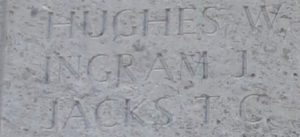
Andrew Richard Jones, Ordinary Seaman, J/81911, Royal Navy. Andrew was born on 6 December 1899, the son of Richard Charles Jones and Mary Ellen Jones (nee Peate), of Trederwen Cottage, Arddleen. He worked as a farm hand prior to enlisting into the Royal Navy on 14 December 1917 and was posted to HMS Victory I at Portsmouth for training. Andrew had not been at Portsmouth long when he took ill and was taken to Haslar Royal Naval Hospital for treatment. He died there of meningitis on 28 January 1918, aged just 18. Andrew was buried in Haslar Royal Naval Cemetery, Portsmouth.
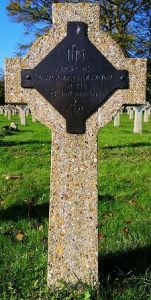
Edward Jones, Stoker 1st Class, K/20796, Royal Navy. Edward was born on 25 August 1894, the son of Thomas and Grace Jones, of 9, Canal Road, Four Crosses. He worked as a farm labourer prior to enlisting into the Royal Navy on 8 October 1913 and was posted to HMS Victory II for training as a Stoker. Over the coming years, Edward had several postings, interspersed with spells back at HMS Victory: HMS Attentive III; HMS Venerable; HMS Ganges; HMS Dolphin; HMS Titania; and HMS Crescent. His last posting was aboard the submarine HMS K17. She had been built by Vickers at Barrow-in-Furness and launched on 10 April 1917. On 31 January 1918, K17 was taking part in fleet exercises, attached to the 13th Submarine Flotilla. K17 was leading the line of submarines, when she was hit by HMS Fearless, and sank in less than ten minutes, with all hands. Edward was 30 years old when he was lost in the sinking. He has no known grave, and is commemorated on the Portsmouth Naval Memorial, Hampshire. His brother, William, was killed in France in 1917.
William Jones, Private, CH/1335(S), Royal Marine Light Infantry. William was born on 11 April 1896, the son of Thomas and Grace Jones, of 9, Canal Road, Four Crosses. He worked as a cowman at Street Farm, Guilsfield prior to the war. William enlisted into the Royal Marines at Birmingham on 17 December 1915, and was posted to the Recruit Depot at Deal for training. On 28 June 1916 he joined the Royal Marine Brigade, and on 25 September 1916 was posted to the 4th Entrenching Battalion, before being posted to the 1st Royal Marines Battalion, 63rd (Royal Naval) Division. He joined the Division on the Somme, in time to take part in its baptism of fire in France, during the Battle of the Ancre. William became ill during the winter, before re-joining the battalion at Arras the following spring. He was killed in action during the Battle of the Scarpe on 28 April 1917. The 21-year-old has no known grave and is commemorated on the Arras Memorial, France. His brother, Edward, was killed at sea the following year.
Cecil Kilvert, Private, 291039, Royal Welsh Fusiliers. Cecil was born in Ruyton XI Towns in 1897, the son of Joseph Kilvert and Mary Jane Kilvert (nee Brown). The family had moved to Llansantffraid-ym-Mechain by 1911. Cecil enlisted into the 4th Battalion, Royal Welsh Fusiliers at Wrexham and was drafted to France in the winter of 1916-17, joining the 2nd Battalion, Royal Welsh Fusiliers, which was attached to 19 Brigade, 33rd Division. The 2nd RWF had suffered terrible casualties on the Somme during August 1916 before the 33rd Division was relieved at the end of the month. During the coming weeks the 2nd RWF received several drafts of reinforcements, and on 8 December the now fully rebuilt battalion moved to new positions at Suzanne, between Bapaume and Péronne. The Division remained in this sector over the coming months, before being transferred to the Arras sector, and reached Henin by 13 April, before the Division took over a section of front line facing the Hindenburg Line. The infantry battalions of the division then began the usual routines of rotating between the front-line, support and reserve trenches and the 2nd RWF took over a position known as Tunnel Trench. On 23 April the 2nd RWF took part in a costly assault on the Hindenburg Line, suffering heavy casualties. The battered battalion then moved to a rest camp at Basseux to rebuild, and by 15 May moved back into the line in the Croisilles Sector. The Division then carried out several assaults against the Hindenburg Line, but could not breach it, so on 27 May a large-scale assault was carried out again, with the 2nd RWF in the thick of the action. Cecil was killed in action during the assault that day, 27 May 1917. The 20-year-old has no known grave and is commemorated on the Arras Memorial, France.
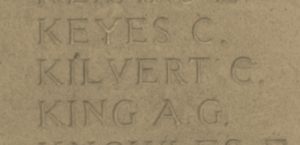
Audley Andrew Dowell Lee, MC, Captain, Leicestershire Regiment. Audley was born at Deytheur, Llansantffraid-ym-Mechain on 3 April 1895, the second son of Reverend William Benjamin Dowell Lee and Katherine Lee (nee Middlemass). He was educated at Oundle and then at Lincoln College, Oxford, where he joined the Officer Training Corps. Audley was commissioned as Second Lieutenant into the Leicestershire Regiment from the OTC on 22 December 1914. Audley embarked for France on 21 November 1915, and joined the 9th Battalion, Leicestershire Regiment, which was at Bienvillers attached to 110 Brigade, 21st Division. The Division was holding the line in the Monchy sector at the time of Audley’s arrival, following heavy losses at Loos in September. In May 1916 the Division moved to the Somme, taking over a section of the line at Hannescamps. The Division remained in reserve during the opening days of the Somme offensive but on 10 July took over positions at Quadrangle Support and Trench before taking part in the attacks on Bazentin Ridge after the 38th (Welsh) Division withdrew from Mametz Wood. Audley was conspicuous in his bravery whilst leading his platoon during the ensuing fighting and was promoted to Captain in October 1916, gaining command of A Company, then was awarded the Military Cross for his gallantry throughout the Somme campaign. The award was published in the 1917 New Year’s Honours List. In March 1917 the Division followed the German Retreat to the Hindenburg Line, and in April fought at Arras, during the First Battle of the Scarpe, the Third Battle of the Scarpe, and the Flanking Operations Round Bullecourt. During September 1917 the Division moved to Ypres, and by 30 September had moved into the line east of Polygon Wood. During the early hours of 1 October 1917, the Division was subjected to an intensive artillery barrage and minutes later the line was hit by waves of German infantry, who had crossed No Man’s Land behind the screen of the barrage. Audley, leading his company from the front, was killed soon afterwards. The 22-year-old has no known grave and is commemorated on the Tyne Cot Memorial, Belgium.

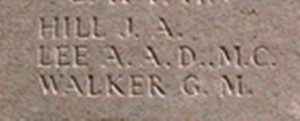
Samuel Herbert Lewis, Private, 108838, Sherwood Foresters (Notts and Derby Regiment). Samuel was the son of Samuel and Jane Lewis, of Mardu Farm, Llanymynech. He worked as a shepherd prior to enlisting into the Royal Field Artillery at Welshpool on 7 February 1916 and was initially placed on the Army Reserve. He was mobilised on 28 April and posted to Preston, joining the 7th Reserve Battery, Royal Field Artillery. Samuel was transferred to the 3rd Battalion, Lancashire Fusiliers on 17 June and embarked for France on 28 September 1916, joining the 15th Battalion, Lancashire Fusiliers, which was on the Somme attached to 96 Brigade, 32nd Division. The Division had taken part in heavy fighting during the opening stages of the Somme offensive and then took part in the Battle of the Ancre and the resulting Operations on the Ancre. The Division remained on the Somme over the winter, and in March 1917 followed the German Retreat to the Hindenburg Line. On 14 May 1917 Samuel returned to England, suffering from dysentery. He was drafted back out to France on 31 March 1918 and was posted to the 1st Battalion, Sherwood Foresters, which was attached to 24 Brigade, 8th Division. The Division was rebuilding in the Hangest area, following heavy losses following the launching of the German offensive of 21 March 1918, which saw the Division take part in a gallant Rearguard action over the Somme crossings. As soon as it was up to strength the Division was moved south to the Aisne sector. Unfortunately, the Germans launched the third, and final stage of their offensive on the Aisne on 27 May 1918 and the 8th Division was caught up in terrible fighting near Bligny. Samuel was killed in action here on 1 June 1918. The 26-year-old was buried in Sissonne British Cemetery, France.
David Edward Lloyd, Private, 12226, Royal Welsh Fusiliers. David, known as Edward, was the son of Edward and Ann Jane Lloyd, of Genffordd Cottage, Guilsfield. He worked as a waggoner at Llanymynech prior to the war. David originally enlisted at Welshpool into the Montgomeryshire Yeomanry and was posted to Park Hall Camp, Oswestry for training. He was drafted to France early in 1916, joining the 1/4th Battalion, Royal Welsh Fusiliers, which was the Pioneer Battalion to the 47th (2nd London) Division. In October 1916 the Division had moved north to Belgium from the Somme sector, taking over a section of the front line running south from Hill 60 to the Ypres-Comines Canal. The 4th RWF then began work on road repairs and improvements as well as laying railways and trench tramways over the coming months. The battalion was at work on a broad-gauge railway near The Bluff on 13 January 1917 when David was killed in action, the sole casualty in the battalion that day. The 23-year-old is buried in Bedford House Cemetery, Belgium. His brother, John Edward Lloyd, died in France just after the Armistice.
George Nelson Lloyd, Private, 30719, East Lancashire Regiment. George was the son of Richard and Jent Lloyd, of Court House Cottage, Llandysilio. He enlisted into the army at Wrexham, and after completing his training was posted to France, joining the 11th Battalion, East Lancashire Regiment, which was attached to 94 Brigade, 31st Division. He would have joined the battalion in the late summer of 1917, while it was in the Arras sector, near Ecurie. The Division was holding the Oppy Sector of the Arras front and had a relatively peaceful time over the winter of 1917-18, suffering very few casualties. During February the 11th East Lancs transferred to 92 Brigade, in the same 31st Division, following the re-organisation of the British Army in France. Over the coming weeks the infantry battalions of the Division continued to carry out the usual routines of trench rotation, normally four days in the front line, four in support and four in reserve. The battalion was in reserve at Marquay when the Germans launched their Spring Offensive on 21 March 1918, along the section of front running from Croisilles to La Fère, and on the following day was ordered to move forward to Bailleulval, taking over a section of defensive line east of Boisleux St. Marc. On the following day the battalion took over a new defensive line in front of Ervillers, where it awaited the German onslaught. On 25 March information was received that the Germans had broken through at Gomiecourt, and the 11th East Lancs was ordered to withdraw. On 27 March the Germans hit the line held by the battalion, and fierce fighting ensued. George was killed in action near Adinfer Wood on the following day, 28 March 1918. The 19-year-old has no known grave and is commemorated on the Arras Memorial, France.
James Macdonald, Corporal, 6233, Somerset Light Infantry. James was born at Penrhos in 1887, the son of Angus Macdonald and Jessie Macdonald (nee Forbes), of Trefnwy Bank, Penrhos. His father was a gamekeeper, who had moved to the village from Scotland to work at Penrhos Hall. James was baptised at Penrhos Church on 22 May. By 1911 James was lodging at 116, Wellington Street, Sheffield, where he worked as a labourer in an ironworks. James married Alice Bolsover, of 2, Strand Street, Sheffield, in the spring of 1911. He enlisted into the 1st Battalion, Somerset Light Infantry in London at some time prior to the war. The battalion was at Colchester attached to 11 Brigade, 4th Division when war was declared, and James embarked for France with the battalion on 31 August 1914. The 4th Division arrived in France just in time to join the hard-pressed Divisions of II Corps at The Battle of Le Cateau. It then took part in the epic retreat to the Marne, where the German Offensive was halted, and in the advance to the Aisne, in the action which saw the Germans forced to entrench along the Chemins-des-Dames Ridge. The Division was then moved north to Flanders with the BEF in October, with the BEF taking up positions guarding the city, in a line running down into France, near Neuve Chapelle. The 4th Division took over a section of the line near Ploegsteert Wood and saw heavy fighting during the Battle of Messines, a sub-action of the First Battle of Ypres, when the BEF helped stem the German drive towards the Channel coast. James was killed in action soon afterwards, during a routine spell in the flooded Ploegsteert trenches on 7 December 1914. The 30-year-old has no known grave and is commemorated on the Ploegsteert Memorial, Belgium. James does not appear to be commemorated locally.
William Edward Tisdale, Private, 3275, Royal Welsh Fusiliers. William was the son of William Tisdale and Eliza Tisdale (nee Jones), of Bronheulog, Deythur, Llansantffraid-ym-Mechain. He enlisted at Welshpool into the 7th Battalion, Royal Welsh Fusiliers soon after the outbreak of war. The battalion was a Territorial unit, which mobilised for war at Newtown in August 1914, as part of North Wales Brigade, Welsh Division and moved to Conway until the end of the month, before moving to Northampton. In December the Division moved to Cambridge and then in May 1915 to Bedford, where the Division was numbered and the formation became 158 Brigade, 53rd (Welsh) Division. On 19 July 1915 the entire Division sailed from Devonport for Imbros and on 9 August 1915 landed at Suvla Bay. The infantry moved off the beaches across the Salt Lake, under shellfire, into the scrub covered Chocolate Hill, but due to a lack of maps and no knowledge of the terrain, many of the units became disorientated, and the situation became chaotic. After the fighting died down, the winter rolled in, and the men first had to endure torrential downpours, which flooded the trenches, before the snow hit, and many men began falling ill in the terrible conditions. William took ill during the terrible winter of 1915-16 and was evacuated by hospital ship to Mudros island. He died of enteric fever at the 5th Australian General Hospital, Mudros on 12 November 1915. The 19-year-old is buried in Portianos Military Cemetery, Lemnos, Greece.
Richard Vaughan, Private, 74741, Machine Gun Corps. Richard was the son of John Edward and Jane Elizabeth Vaughan, of The Hollies, Waen Fach, Llansantffraid-ym-Mechain. He worked as a waggoner at Bryndial Farm, Welshpool prior to the war. Richard enlisted at Welshpool into the Montgomeryshire Yeomanry. On 5 August 1914 the Montgomeryshire Yeomanry was mobilised at Welshpool, as part of the South Wales Mounted Brigade, before moving via Hereford to Thetford, to join the 1st Mounted Division. On 4 March 1916 the 1st Mounted Division sailed for Egypt to join the EEF. On 4 March 1917 the battalion merged with the Welsh Horse Yeomanry to form the 25th (Montgomery & Welsh Horse Yeomanry) Battalion, Royal Welsh Fusiliers, as part of the newly formed 231 Brigade, 74th (Yeomanry) Division. Richard was then transferred to the 210th Company, Machine Gun Corps, which was attached to the same 74th Division. The Division had assembled in Egypt as part of the EEF, before crossing the Suez Canal into the Sinai, and saw its first major action during the Second Battle of Gaza. The battle was a failure, and the EEF was re-organised under a new commander, Sir Edmund Allenby, before launching the Third Battle of Gaza on the night of 31 October 1917. This assault was launched along a winder front, running from Gaza to Beersheba, and this time the EEF prevailed, opening the door to Jerusalem. Richard was killed in action at Beersheba on 31 October 1917. The 24-year-old is buried in Beersheba War Cemetery, Israel.
